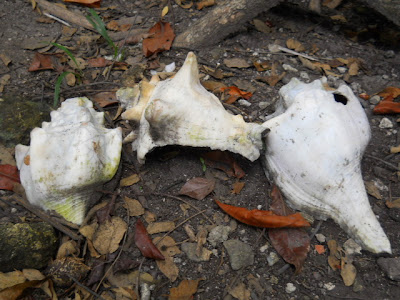Laurie-aka Tacogirl, Anthony, Robin, Me (Gigi is hiding behind me), Ann, Cherie, and Jan.

Marco Gonzalez Archaeological Reserve
The Entrance
Getting ready to head out to the site.
The road south to Marco Gonzalez
Today was a nice, sunny day and the perfect way to start out on our search for mangroves at the Marco Gonzalez Archaeological Reserve. Marco Gonzales is a 2000 year old Maya site located on the southern part of Ambergris Caye. Our guide was the lovely and knowledgeable Jan Brown. Jan is from the US and has been living in San Pedro for many years. She has been seeking to preserve, develop, promote and educate people about the Marco Gonzalez Archaeological Reserve.
The boardwalk
Breaking up wooden pallets to use to repair rotten boards on the boardwalk.
They are building an outhouse for the reserve.
Marco Gonzalez is only one of 18 Maya sites recognized on the 25 miles long island of Ambergris Caye. April 1st, 2011 the final paperwork was signed with the Belizean government to make Marco Gonzalez the first Maya Site National Park on Ambergris Caye.
The jungles.
See the termite nest in the tree.
Termite Nest
These trees can cause a nice rash.
Eight of us met up Wednesday morning, we are volunteers for Direct Abundance, an education and community development organization which aids developing countries in mangrove planting and conservation. We met at 9:30 am and traveled on golf carts down the sandy bumpy road south and headed to the Marco Gonzalez site. We came loaded down with plastic crate, bags, shovels, water and mosquito spray and ready to find our mangroves.
Preparing to go into the jungles.
Jan showing us where we are going on the map.
Map of the site.
Once we arrived at the entrance of the site, Jan led us down the wooden walkway about a quarter of a mile in to the jungles and where our adventure began. First thing we spotted on the walkway was a blue parrot head snake which slithered on past us. Next we passed the crocodile crossing, but he was no where to be found today.
Croc Crossing

Parrot Head Snake (photo by Gigi)
We stepped off the wooden walkway and on to the jungle floor, we saw thousands of pieces of broken Mayan pottery in all shapes, sizes and colors. Jan also showed us some very old Mayan human bones. The ground floor of the jungle was littered with conch shells brought on to land from previous hurricanes.
Pieces of Mayan pottery.
Mayan Human Bone.
Jan showing us more pottery pieces.
Conch Shells
We then spotted our first black mangrove seedlings that were plentiful on the ground. We dug up about 200 mangrove plants along with some nice black soil to re-plant them in. We carried them out of the jungle in our plastic crate and bags. We took turns carrying the crate, it was pretty
heavy and thank goodness Valentine Rasado with The Coral Reef Alliance showed up with a helping hand. Cherie Rose with ACES, American Crocodile Education Sanctuary was taking all of our mangrove plants to the Holy Cross Anglican School in San Mateo where the children will help re-plant the mangroves and they will get to name the trees.
Jan showing us a mangrove seedling that has taken root in a conch shell.
Gigi digging for mangrove seedlings.
Getting the dirt we needed to replant the mangrove seedlings.
Black Mangrove Seedlings.
Carrying the seedlings out of the jungle.
Bagged and ready to be delivered to San Mateo.
On the way back to town, we stopped off at a project that Valentine is working on with the red mangrove. It was very interesting how they plant and grow the mangroves.
Mangrove roots.
A mangrove seedling starting to peep out of the tube.
The red mangroves are planted in tubes in the water.
Valentine explaining how this all works.
These mangroves have been growing about 10 years.
Red Mangroves ready to plant.
















































Excellent post - this should attract more visitors to the site!
ReplyDeleteThanks AJ....we had a great time and it was so nice meeting everyone involved.
ReplyDeleteWhat a neat thing to do! wish I could have joined you. Maybe next time...
ReplyDelete